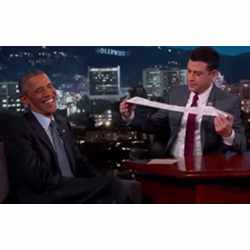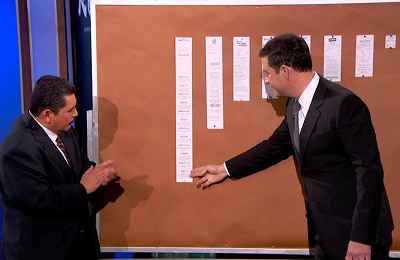
Late night television host Jimmy Kimmel has been on a crusade since January against the excessively long paper receipts issued by retailers. Printed receipts include a proof of sale, as well as coupons and other promotional information, resulting in sometimes comically long paper receipts. Kimmel has even gone so far as to ask President Obama to step in and do something about the problem. While an executive order banning paper receipts is unlikely, electronic receipts have emerged as a tool to digitize and potentially reduce retailers’ reliance on the printed receipt.
Digital receipts are being offered by a growing number of retailers, and could be just what retailers need to help lessen the flow of paper receipts. By collecting an email address or mobile phone number at the point of sale, merchants are able to send customers a digital copy of a receipt; they are also using the technology to further engage with the customer after the sale.A survey by Retail Info Systems News found that while fewer than one-quarter (22.7%) of retailers current offering digital receipts, 54.6% of retailers plan to implement the technology within the next 18 months. The Retail Info Systems News survey found that difficulty integrating with point of sale systems was the top obstacle in the deployment of a digital receipt system, cited by 56.1% of retailers. This challenge necessitated the development of a set of standards to enable retail systems to integrate with digital receipt technology. The National Retail Federation (NRF), the leading advocacy group for the retail industry, has developed the Digital Receipts Schema, “a standard XML message set that allows two applications to exchange information in a standard fashion.”
Jimmy Kimmel and sidekick Guillermo Martinez examine the growing length of simple paper receipts. Credit: Jimmy Kimmel Live
One vendor that subscribes to the Digital Receipts Schema is flexReceipts. Jay Patel, the company’s chief technology officer, emphasizes the need for near-real-time data: “Paper receipts are printed and presented to customers as a proof of purchase in real time, and so electronic receipts should be real time as well. The challenge is to ensure you can quickly produce and email the electronic receipt so that it is in the customer’s email inbox before they leave the checkout lane.” flexReceipts’ API uses lightweight messages that require as little as a single web service call to gather data from the retailer, rendering and emailing custom receipts within seconds of a customer’s purchase.
The ability to offer customers receipts by email or on their mobile devices solves a number of problems.
First, customers have a more permanent record of their purchases in digital form, which can be useful for product returns, as well as serving as proof of purchase for warranties and rebates.
Electronic receipts can also serve as a tool for marketing and promotion, which can increase customer engagement and result in more sales. The coupons printed on the bottom of paper receipts can be replaced with an email or text message with offers that retailers hope will prompt customers to shop more frequently. The NRF has reported “customers who use digital receipts spend up to 40% more than those who only want paper receipts.”
Walmart, the largest retailer in the world, launched a well-developed e-receipt mobile application in June 2014, which provides customers with multiple benefits. The application, Savings Catcher, stores customers’ receipts on their mobile devices, while also searching competing stores for lower prices; the app provides customers with refunds for any differences that it finds. This system is extremely complex, requiring Walmart to review prices on thousands of items at some 80,000 competitor stores nationwide.
Retailers that migrate to digital receipts can also reduce their carbon footprint, with the added benefit of spending less on paper and printing. A frequently-cited paper from AllEtronic found that 640,000 tons of paper receipts are produced each year, consuming 9.6 million trees and nearly 250 million gallons of oil for their production.
Completely eliminating paper receipts, however, is not likely to happen any time soon. The reality is that digital receipts are generally offered as an additional option to customers, and not necessarily as a replacement for paper. Walmart’s Savings Catcher app, for example, requires customers to scan a barcode from their printed receipt in order to transfer purchase data into the mobile application. Other retailers ask patrons if they would like a digital copy of their receipt emailed to them, but still provide a paper copy at the point of purchase.
Retailers want to reduce checkout times at the point of sale, but having customers register for electronic receipts adds additional time and steps to the checkout process. This is yet another obstacle for retailers, as they must weigh the added friction in the transaction process with the benefits derived from the digital receipt program.
While the expanded ability to market to customers is a great outcome for retailers, they need to be careful not to overstep boundaries in communicating with customers. When a customer agrees to have a receipt emailed to them, they are not necessarily opting in for all of a retailer’s marketing. Retailers that have an opt-in mechanism during the electronic receipt registration process ensure that only customers that wish to receive marketing communications will receive them.
Digital receipt technology is only beginning to gain traction in the marketplace, but companies are already looking at how the next generation of electronic receipts will appear. flexReceipt’s Jay Patel says retailers “want a more enriched electronic receipt. Basic image-based electronic receipts are simply static PDF or JPG copies of a standard paper receipt. An enriched digital receipt is a dynamic electronic receipt that supports customized designs, offers, videos, surveys, social media and more.”
Jimmy Kimmel may see his dream of eliminating unnecessary paper receipts come true. As the market matures, we are likely to see not only a greater number of merchants offering digital receipts, but more of these enhanced features.
Mark Broderick is a Tampa, FL-based senior research analyst covering the financial services and payments industries for ORC International.




Join the Discussion (0)
Become a Member or Sign In to Post a Comment